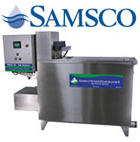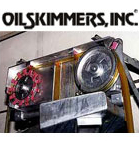pH
The measurement of pH is a value taken to represent the acidity or alkalinity of an aqueous solution; it is defined as the logarithm of the reciprocal of the hydrogen ion concentration of a solution:
pH = log 1/[H+]
Pure water is the standard used in arriving at this value.
Under ordinary conditions water molecules dissociate into the ions H+ and OH- with recombination at such a rate that with very pure water at 22 degrees C there is a concentration of positively charged ions of 1/10,000,000 moles per liter. This is commonly expressed by saying that pure water has a pH of 7.
When acids or hydroxyl-containing bases are in solution they ionize more or less completely, furnishing varying concentrations of H+ and OH- ions, respectively, to the solution. Strong acids and bases ionize much more completely than weak acids and bases, thus strong acids give solutions a pH of 1 to 3, while solutions of weak acids have a pH of about 6. Strong bases give solutions a pH of 12 or 13, while weak bases give solutions a pH of near 8. As the pH scale is logarithmic, the intervals are exponential, and thus represent far greater differences in concentration than the values themselves seem to indicate (See table).
pH Value |
Ratio of H+ or OH- |
||||||
| 1 | 1,000,000 | ||||||
| 2 | Acid Side, | 100,000 | |||||
| 3 | excess of | 10,000 | |||||
| 4 | H+ ions | 1,000 | |||||
| 5 | 100 | ||||||
| 6 | 10 | ||||||
| Neutral | 7 | ||||||
| 8 | 10 | ||||||
| 9 | Alkaline Side, | 100 | |||||
| 10 | excess of | 1,000 | |||||
| 11 | OH- ions | 10,000 | |||||
| 12 | 100,000 | ||||||
| 13 | 1,000,000 | ||||||
Liquid |
pH VALUE |
| Pure Water | 7 |
| Sea Water | 8.5 - 10 |
| .01 N HCL | 2 |
| .01 N NaOH | 12 |
| .1 N Acetic acid | 3 |
| .1 N NH OH | 11 |
| Gastric Juices | 2 |
| Urine | 5 - 7 |
| Blood | 7.3 - 7.5 |
| Milk | 6.5 - 7.0 |
In acid-base titrations, changes in pH can be detected by indicators such as methyl orange, phenolphthalein, etc... or pH can be measured with a meter.
pH control is of critical importance in a large number of industrial operations such as water purification, chrome tanning process for leather, in preservation of food products, in electroplating baths, dying, agriculture, and numerous other instances.







